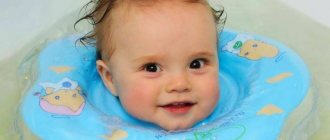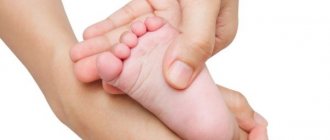How is swimming good for babies?
From birth, children are already able to swim: they can hold their breath under water and splash with pleasure in the bathtub. This is explained by innate reflexes - before birth, the baby in the mother’s stomach was in a liquid environment. Around three to four months, this innate reaction fades away, and the baby will have to learn to stay afloat much later.
However, the point of such activities with a newborn is not to make him a future Olympic champion. Increasingly, pediatricians are saying that infant swimming brings invaluable benefits .
- Regular water procedures teach children to be calm about temperature changes. Thanks to hardening, the immune system is strengthened, which reduces the likelihood of colds, promotes dynamic physical development and helps prevent a variety of health problems.
- The result of systematic exercise is the formation of correct, beautiful posture, a strong muscle corset for the children's spine.
- Water exercises are much more effective for improving the motor system than massage and stroking. They strengthen or, conversely, relax the muscles of the back, arms, legs and neck. By the way, young swimmers begin to crawl, stand up and walk earlier (which a child of 1 year can do).
- During bathing, when the child has a little difficulty breathing and the body lacks oxygen, the child’s body additionally releases red blood cells (erythrocytes), which contributes to an increase in hemoglobin levels.
- Swimming and diving have a positive effect on the lungs and cardiovascular system, help stimulate blood supply to organs and normalize blood pressure.
- When a child dives, the flowing water clears the maxillary sinuses. And this is the prevention of a runny nose in a newborn. The baby's nose is also washed, all bacteria, dust particles and possible allergens are removed.
- In water, the child calms down and gets rid of fears. Also, water procedures strengthen the bond between mother and baby, devoting time to the baby while swimming, you can better understand his body language and gestures, which will allow you to quickly find mutual understanding with your baby.
- A child taught to swim from birth will not be afraid of open water.
Another undoubted plus is that many children, after swimming and diving, quickly fall asleep and do not disturb the young mother almost all night. Which, you see, is important!
READ ON THE TOPIC:
Rules for swimming with a baby
Teaching a newborn to swim will not be difficult for parents if you follow the basic recommendations.
Optimal age
Training should begin at three to four weeks. Firstly, by this time the umbilical wound is healing. Secondly, the child gains weight and gradually adapts to the new reality. Finally, infant reflexes (swimming and breathing) have not yet faded.
Preparing the bath
All procedures should be carried out in a familiar environment for the baby. Before immersion, wash the bathtub with regular laundry soap, and once a week rinse it with soda, remembering to rinse thoroughly. Be careful with potassium permanganate solution and herbal decoctions - the child may swallow the liquid. After gaining basic swimming skills, you can move on to more advanced lessons - in the pool.
Water temperature
Perform your first workouts at an average temperature of 35 °C. It can be reduced little by little, but remember - small children under three months should not swim in water whose temperature is below 32 °C. To create ideal conditions, monitor children's behavior:
- if the baby cries when immersed for several minutes, the water is too cold for him;
- if he first whines, and then falls silent and actively flounders with his arms and legs, you have selected the optimal temperature;
- if he is too relaxed and passive, the bath is too warm.
While swimming, the water gradually cools down, but do not rush to bring it to its original temperature. This is the meaning of the procedure - the babies are hardened.
Learning to dive and swim: when can you start?
Teaching a child to dive and swim confidently under water is a good idea, but there is an important condition - the child must have his own motivation or at least consent to do this. And this is not the only condition: the ability to stay on the water is important, as well as the absence of contraindications to freediving.
Source: Shutterstock
It is unlikely that any modern parent will disagree that the ability to float on water is vital. After all, sometimes it turns out that the ability to swim well, dive and hold your breath under water saves you from mortal danger.
Inflatable pool, circle, arm guards, vest: 9 swimming aids for this summer
Of course, you can simply learn “not to drown” in your own bath, but to truly master freediving skills you need an experienced coach, an instructor who will advise, guide, identify shortcomings and help overcome fears. And, perhaps, it will teach you to enjoy being in a wonderful body of water. It has been scientifically proven that exercise in water hardens and trains the vestibular apparatus, and holding your breath under water—freediving—helps reduce increased muscle tone and develops the lungs. Starting from the age of five, children are shown group classes in the pool. It is at this tender age that they begin to understand that a coach is a coach, and they must, in fact, listen to him carefully. At the same time, you can try to master the first elements of freediving.
Source: pixabay
Its time to begin?
Children who are familiar with water love to swim and dive. They calmly train at depths even greater than their height. Toddlers love to touch the bottom or grab a handful of sand to prove their accomplishment. All these facts, one might say, are the “first indicators” that the child is ready to learn. But if your child has a fear of water or depth, you should not force him to learn freediving. It’s better to work out with it for some time at shallow depths - where your head will always be above the water if you stand on your feet. The complexity of tasks should be gradual. Only when the child can easily master the depths and skills he has covered. The first rule: no violence and haste! You need to give your child time to get to know the water and build a trusting relationship with it. It is always worth starting training small. Just splash in the water, then learn to hold your breath and dive for toys.
Source: pixabay
Trust in water
Remember that you can scare a baby with water quite easily, but regaining trust in it is much more difficult. Teaching scuba diving to children is somewhat different from courses for adults. The task of a children's instructor is to explain rather complex things to the child in simple and accessible language. Oddly enough, children master the theoretical part of learning faster than adults. This happens because a child’s brain is tuned to learn new material better than an adult’s. Instructors assure that children are open and do not hide their desires or dissatisfaction. Children tend to be impatient, so group size should be limited. It is better that in a group of beginners learning freediving there are no more than three students per trainer.
With mom in the bath: how to teach a baby to dive
Immersion skills
Young swimmers are smarter and more capable students than adults. They grasp everything faster and do not have those numerous fears and phobias to which their parents are so susceptible. Of course, the first classes are held in the form of a game and elementary exercises are practiced during them. The first thing children learn during training is how to blow. Children, starting from a certain age, master the skill of equalizing pressure very successfully, although not always quickly. The next skill - preparatory breathing and relaxation - is given to children, as a rule, a little longer than blowing. However, the guys can be convinced that if they prepare correctly, they will hold their breath longer. Next, children learn recovery breathing. The practical part of training in water is carried out accompanied and under the mandatory supervision of an instructor. The child is taught not just to hold his breath, but to subsequently organize, plan and control his dives. But we must not forget that no matter how responsible and careful a young athlete is, the child has a limited measure of responsibility for his actions, and therefore all concern for a safe dive falls on the adults accompanying him. One of the important and difficult tasks of an instructor is not just to teach how to dive, but also to instill behavior skills in an emergency situation that will allow you to act without mistakes in the future.
Source: pixabay
Hold your breath
Getting a modern child to go to class is difficult. This doesn't just apply to swimming. It is important to catch the moment when he is still small, so that going to the pool becomes a habit. It is necessary to interest and motivate. The child will learn to dive with greater enthusiasm if the parents can interest him by personal example - after all, children first of all strive to imitate adults. As a rule, the goal of children's activities is not to achieve prolonged breath holding or diving deeper and deeper. Basically, parents set themselves the goal of improving the health of their children, instilling in them a love of water, and teaching them new skills.
TOP exercises after which your child will definitely learn to swim
What parents should not do when teaching:
• scold if something doesn't work out; • compare with other children; • shame for failures and awkwardness; • interfere with the learning process; • interrupt the coach; • to say that there is nothing scary in water is not true. And most importantly: you can only dive under adult supervision!
Text author: Tatyana Belonozhkina
How to conduct infant swimming lessons?
Water procedures should be performed approximately an hour after eating: the baby is not yet hungry, and the milk has already been absorbed. Another important point - work only with well-rested children to avoid tears and whims.
Leaning over the bathtub while holding your baby in the water is quite difficult - it affects both your back and shoulders. Try doing this while sitting on a chair. Be sure to cover the floor in the bathroom with a rubber mat so that it is not so slippery. Take a clean diaper with you so you can dry your newborn after the swim. You can also wrap your baby in it before bringing him into the nursery. However, if there are no drafts in the apartment, doctors recommend slightly blotting the baby’s skin without wiping it dry, and taking him to the crib naked. This is another effective way of hardening.
So, everything is ready for swimming - the bath is filled with lukewarm water, and your child is in a great mood. First, touch the water surface with your hand, then immerse your child’s feet in it. Lower the baby vertically, without stopping talking in a confident, calm voice.
In infant swimming, two types of supports are used: under the chin and under the back of the head. In the first case, the baby lies on the water with his stomach down, and you hold his head so that the baby's chin is in your palm. In the second option, the child lies on his back, and you grab his head by the back of his head. Try both positions and choose the one your child likes the most.
Basic exercises in the bath
(at the end of the article there are many video instructions about what exercises you can do with a newborn in the bath)
If you think that water procedures at home are an uninteresting event, then you are mistaken. Of course, the baby will not have the opportunity to perform complex somersaults under the guidance of an instructor, but you can carry out several simple manipulations on your own.
Contraindications to classes
Before starting systematic water procedures, consult your pediatrician. He will explain whether this activity is suitable for your child and identify any limitations. Swimming is contraindicated if you have the following health conditions:
- disorders of the musculoskeletal system, which require fixation of the limbs;
- congenital heart diseases;
- purulent dermatitis;
- colds and viral diseases (after treatment you can swim);
- neurological disorders that are accompanied by seizures.
Remember that you cannot insist and force children to bathe, swim, and especially dive. Such efforts will not add health to the baby, but, on the contrary, will lead to psychological problems.
So, infant swimming is an extremely exciting and extremely useful activity. The child is immersed in a familiar environment, develops the muscular system, strengthens the immune system and learns about the world around him. Babies who started swimming from the first days of life adapt better to the conditions of kindergarten and school. Isn't this a good reason to go swimming with your child?
READ ALSO: Review of popular methods of early child development with video consultations and films - https://razvitie-krohi.ru/razvitie-rebenka-do-goda/metodiki-rannego-razvitiya-detey.html
PS You can search on the Internet for two books by the authors Nikita Yanushchanets and Z.P. Firsov “Swimming before walking” and download for free.
Indications for baby swimming
Swimming and diving for babies is useful, and even necessary, to improve health. There are diseases in which water activities are a real salvation for a child. The list of such serious congenital and acquired childhood pathologies includes:
- hypotonicity or hypertonicity of muscle tissue;
- severe underweight;
- birth by caesarean section;
- developmental abnormalities of the musculoskeletal system;
- cerebral paralysis;
- curvature of the cervical vertebrae;
- dysfunction of the joints.
What is infant swimming
Swimming is very good for health, especially for the physical development of a child. But when exactly should you start exercising in water? This is a question many parents ask. Supporters of infant swimming are sure that you need to start as soon as the baby is two to three weeks old. Experts in early swimming say that you can wait up to a month or a month and a half, but do not delay the start of classes, because the innate reflex to swim gradually fades away from the moment of birth, and is completely forgotten already at the age of three months.
You need to start classes with children before they are three months old, preferably earlier: about a month. It is at this time that the baby still remembers how to hold his breath under water
Many parents are sure that early swimming is necessary in order to teach their baby to swim. This is not true: the basis of exercises in water for babies is general strengthening of the body.
The baby spent nine months in his mother's belly, and was there in the water. He is familiar with this environment, his consciousness still remembers what it’s like to be in water. Infant swimming experts are confident that with the help of exercises in the water, the baby will better adapt to an unfamiliar world. The child learns to stay on the surface of the water and hold his breath when diving. These skills are familiar to him, you just need to not let the body forget them, but simply push the baby to develop them.
No matter how much parents are supporters of infant swimming, it is not recommended to independently decide on the possibility of exercising with a newborn in the water. If parents decide to start such exercises, it is necessary to consult with a number of specialists. A pediatrician, a neurologist and an orthopedist are mandatory on this list. And only after a positive response from all three doctors can the baby be introduced to water.
Baby's first activity in the water - video
The benefits of early swimming for newborns
Everyone knows that water is good for everyone, especially regular swimming. The question is at what age is swimming beneficial? Parents and infant swimming experts give many reasons that reveal the positive aspects of early start of lessons with a baby in the water:
- a newborn baby cannot perform many actions; he just lies in a crib or in his mother’s arms, and can move his arms and legs. When immersed in water, the child becomes 7 times lighter, so the baby can make active movements. It is much easier for him to control his body during swimming. Such activities help strengthen the child’s muscles without additional stress on the still fragile spine;
- prevention of flat feet and scoliosis;
- Light hydromassage has a beneficial effect on the baby’s general condition and has a relaxing effect on the muscles. This is especially useful for children with hypertension;
- helps normalize intracranial pressure;
- has a positive effect on the development of the respiratory system: water puts pressure on the chest, so it is more difficult for a child to inhale, but it is much easier to exhale. This is a kind of simulator, thanks to which all respiratory muscles actively work: the blood supply to the lungs improves, their ventilation increases and the lung capacity increases. Doctors often recommend early swimming for children diagnosed with depressed breathing. This situation is possible after delivery by Caesarean section, or entanglement of the baby’s umbilical cord;
- training and improving the functioning of the cardiovascular system: the water temperature during swimming is about 31–32 degrees, the vessels narrow, which causes more blood to flow to the heart, and this requires more active work of the heart muscle. As a result of these actions, blood supply to all organs and systems of the baby improves. However, you should remember that you start swimming with a water temperature of at least 36–37 degrees, gradually reducing it to 31 degrees;
- has a beneficial effect on the nervous system due to the relaxing effect of water;
- the immune system is strengthened, because swimming in cool water tones the entire body;
- hydromassage affects not only the muscles, but also the gastrointestinal tract: digestion is improved and constipation is prevented. Parents note that children who engage in early swimming practically do not experience infant colic;
- the baby learns not to be afraid of water, and as he grows up he will feel more confident in bodies of water or at sea;
- has a positive effect on the baby's sleep, because after active swimming the baby's body needs a good rest.
Small children underwater: when to start swimming with a baby?
Doctors call the optimal age to start swimming 2-4 weeks after birth, but no later than 3 months. This is explained by the fact that a person is born with a set of certain reflexes to protect the face from an aggressive external environment. After three months, these reflexes gradually fade away, and teaching a child to swim will be much more difficult.
In addition, a newborn baby still remembers the state in which he was in his mother’s tummy, so he will enjoy swimming in the water. The baby will not be afraid of water and will begin to feel natural in it.
If you are not ready to start swimming with your child until he is three months old, you should wait with this idea until he is three years old. After all, this age already requires a slightly different methodology and approach on the part of the child.
However, be sure to consult your pediatrician before taking swimming lessons. After all, while swimming will only benefit some children, swimming for too long can be harmful for others. In addition, without such a doctor’s examination, you yourself may not notice certain contraindications for swimming.
Exercises at home in the bathtub and in the pool: what to choose and whether it is possible to combine
Parents who decide to teach their baby early swimming are faced with a very important question: where to start lessons, in the bathroom at home or in the pool? Experts have different opinions on this matter. Some recommend that babies up to a month or two swim at home, because in a special baby bath it is easier for the child to get used to the water, he is not so scared, and the mother feels more confident. Others argue that from three weeks you can start going to the pool so that the child gets used to a large amount of water and space.
Infant swimming trainers insist that first the child must undergo adaptation in the bathroom: get used to the water, not be afraid to dive in and out. Indeed, when first immersed in water, only a small number of newborns begin to work with their arms and legs. For other children, a coach or mother develops these skills. Only after getting used to the water in a small bath is it better to start exercising in the pool.
Experts explain that you can combine swimming at home and in the pool. But it’s always better to start with a coach or instructor who will show you how to properly immerse a child in water, what exercises you can do, and most importantly, tell you the safety rules so that your baby doesn’t swallow water and get scared.
Infant swimming in the bathtub. Infant swimming rules.
- Suitable age. You cannot teach a newborn to swim in the bathtub immediately after birth. A baby should be taught to swim and dive from 3 to 4 months of age, when the umbilical cord has completely healed. The baby must at least get used to the new environment and unusual living conditions. At four months, the baby is already quite strong and tall, but has not yet forgotten about the swimming instinct.
- Preparing the bathroom. You should not start your first water activity in the pool. A child may be afraid of unfamiliar people and strange rooms. It is better to start exercising in a calm and relaxing home environment. Before filling the bathtub with warm water, you must wash it thoroughly with ordinary laundry soap. It is not recommended to use extracts of medicinal plants or potassium permanganate for bathing babies. When a child swims, he may accidentally swallow water with additives and become poisoned. Once a week, the bathtub in which the baby is bathing should be cleaned with soda.
- Optimal water temperature. It is advisable to carry out the first exercises at a water temperature of +35°C. When the baby gets a little used to swimming, you can use slightly colder water. But the mother needs to remember that a newborn baby cannot be bathed at temperatures below +32°C. It is easy to understand how comfortable a baby feels in the bath by his behavior. If the baby cries heart-rendingly, without stopping, when immersed in water, then he is cold, but if, on the contrary, he is silent and looks lethargic, then he is too hot. The temperature is ideal when the baby is cheerfully and actively waving its arms and legs. While the child is bathing in the bath, the water slowly cools, but it is not necessary to return it to the original temperature. It is useful for a newborn baby to harden up.
The benefits of swimming for babies
Swimming for infants as a widespread practice was proposed back in the 60s of the 20th century. Among modern pediatricians, more and more specialists recognize this method and talk about its undoubted benefits:
- Swimming infants in a bathtub or pool is an excellent way to harden (see also: swimming pants for infants). It not only strengthens the general immune system, reducing the risk of colds and generally increasing the body’s resistance to various viruses and infections, but also has a beneficial effect on the physical development of children.
- If this practice is done regularly, the child develops correct posture and strengthens the back muscles that support the spine.
- The musculoskeletal system benefits significantly more than from massage. Exercises in water tone muscles if done in the morning and relax before bed. It is also noteworthy that children who engage in infant swimming begin to crawl and walk earlier.
- Short-term breath holdings during swimming and diving, accompanied by a slight lack of oxygen, stimulate the formation of red blood cells in the body. As a result, hemoglobin levels increase.
- There is a beneficial effect on the respiratory and cardiovascular systems. Blood supply to internal organs is stimulated and blood pressure is normalized.
- During diving, water enters the nasopharynx and washes away accumulated bacteria, dust, pollen and other allergens. The maxillary sinuses are washed and good prevention of a runny nose is created.
- Water relieves all tension, calms, removes fears and has a positive effect on the entire nervous system. Also, water activities help strengthen the intuitive bond between mother and baby.
- Children who swim from birth (even only at home) in the future do not experience fears of large and open bodies of water - a swimming pool, lake or sea.
What else is useful for infant swimming?
- With regular swimming lessons, children's immunity is strengthened, resistance to temperature changes, as well as colds, appears. Children who go in for swimming develop physically better and are less likely to develop health problems.
- Little swimmers are distinguished by correct posture and a strong muscle corset. They almost never have problems with the spine.
- Infants performing water exercises are not prescribed a massage, since in water the muscles of the whole body are strengthened and relaxed at the same time. Such children begin to walk earlier than their peers.
- In an aquatic environment, under survival conditions, the body releases an additional portion of red blood cells, which increase the level of hemoglobin.
- During swimming, the respiratory system is trained, which activates the blood supply to internal organs.
- Water rinses and cleanses the maxillary sinuses and nasal passages from bacteria and viruses. Therefore, infant swimming is an additional prevention against runny nose and allergies in a child.
- In water, a child becomes self-confident. His fears disappear and he perceives his body language better. Charkovsky’s method also talks about inspired fears and experiences that interfere with the development of the child, which the mother experienced during pregnancy.
- Having learned to swim in a bathtub or pool from infancy, the child will never be afraid of open bodies of water.
- An important and biggest advantage of swimming lessons is adequate sleep for little swimmers. If children swim, they have sound sleep, and, therefore, good health. After all, it is in sleep that the body’s strength is restored and the immune system is strengthened.
Principles of infant swimming
Some parents believe that only an experienced pool instructor who specializes in infant swimming can teach. In fact, everything is not so difficult. Let's see what you should pay attention to when preparing.
- It is better to start water activities at the age of 3-4 weeks. At this time, children have not yet lost their innate reflex to hold their breath under water. In addition, the umbilical wound has already healed, and the child has gained weight and become stronger.
- The bathtub or small pool (if available) must be kept clean. Before the procedures, the container should be thoroughly washed with soap (ordinary household soap will do), and once a week – cleaned with baking soda, rinsing well with plenty of running water. If a swimming ring is used for swimming, it must also be washed thoroughly. It is better not to use a solution of potassium permanganate or herbal decoctions, since when bathing, water can get not only into the respiratory tract, but also into the digestion (we recommend reading: water for bathing a newborn). For the same reason, there is no need to use aggressive chemicals that are difficult to wash off and remain on the surface in small quantities.
- The water temperature for infants during the first three months should be no lower than 32 degrees. You can start with 35 degrees and after several sessions gradually reduce it by 3 degrees. After immersing the baby in the water, you need to watch him. If he starts crying and doesn’t stop for several minutes, it means he’s cold. If it is too sluggish, then the water is hot. If the child quickly gets used to the water and makes all sorts of movements with his arms and legs, then the water temperature is optimal.
Many parents have doubts and fears about diving. The famous pediatrician Evgeny Komarovsky, who speaks positively about infant swimming and water procedures for newborns, also has a good attitude towards diving. He claims that diving is very useful and not dangerous, however, if parents have fear, it is better to refuse diving or postpone it.
How did the history of infant swimming begin?
In the mid-60s of the last century, an ordinary swimming instructor, for whom water was his natural element, had a premature daughter. Since Igor Borisovich was left alone with his problem, the first thought that came to his mind was to place the child in a bathtub with water in order to create gravitational conditions for the body until the moment of adaptation to new conditions comes. In order to survive in new conditions, the baby’s body needed strength, which she did not have enough at that time. And that's what happened. The body, constantly being in water, used all its resources to build the necessary tissues. And three months later, the girl began to outstrip the development of newborn children who were born on time. Moreover, she was ahead not only physically, but also on an intellectual level. The girl calmly dived to a depth of several meters in a pool intended for adults, and by the age of 11, she became the national swimming champion.
The simple, safe and effective method was so unusual that it instantly spread throughout the world. It is not surprising that in our country it was recognized as dangerous and did not receive permission to be put into practice. But in foreign countries they became seriously interested in this technique, and approached the issue of the development of children in the aquatic environment with all seriousness. Special institutes began to open to study the development of children in water and to practice infant swimming. And then schools began to open in European countries, America and Japanese cities.
Having seen such a success of the method, our Ministry of Health by the end of the 70s allowed infant swimming to be carried out in our country. And very soon, health-improving water swimming courses began to open in children's treatment centers.
The chairman of the swimming federation, a physician by profession, Zakhary Firsov, provided enormous assistance in bringing infant swimming to life by publishing a book about children's swimming called “Swimming before walking.” In his book, he described in detail the influence of the aquatic environment on the child’s body from the first days of his birth. He proved that the child's brain is in a state of weightlessness i.e. in water, freed from gravity, it develops much faster. The first sports school for swimming was opened in Leningrad in 1934, and Firsov himself became its director.
Recommendations for conducting home exercises
It is necessary to choose the right time for classes. You should not do this when the baby is hungry, or immediately after feeding; It is better to wait an hour for the milk to be absorbed. Also, the child should be well-rested and alert.
Mom should also think about her own convenience. To prevent your back and shoulders from becoming numb, it is better to sit near the bathtub and lay a rubber mat on the floor to prevent slipping. It’s good to prepare a clean diaper in advance. When the procedures are completed, you can wipe the baby with it and take him to the room in it. Although you can also wear it naked - this will be additional hardening.
When the bathtub or mini-pool is filled with water, you can begin to introduce your child to the water by gently touching it first with one or both handles. Then you can wet your feet, your entire legs, and gradually your entire body. The child should be immersed in water in an upright position. At the same time, you need to constantly talk to him and smile.
Mom needs to try both types of supports used in infant swimming: under the chin and under the back of the head. When the baby lies on the water with his tummy, the mother supports his head so that his chin rests on her palm. If the baby is lying on his back, the mother needs to support the back of his head. You can choose any position that your baby likes best, or use both in turn. You can also try swimming with a swimming ring. After home exercises are well mastered, it is recommended to move to a large pool.
Learn to swim
- The baby can swim on his back, you just need to help him remember the skill. Mom or dad supports the head with one hand, and the butt with the other. So the baby is slowly rolled along the bathtub. For the first time, you can limit yourself to this. On your next swim, support the baby only by the head. Change hands under the head at intervals so that sometimes the baby swims independently. And after a few weeks (for some babies, a few days) he will be able to swim on his own.
- When your baby is on his tummy, support him under his chin and tummy. Just like on your back, give your child the opportunity to swim independently. Your task is to teach the baby to keep his head above the water.
Learning to swim: the mother holds the child with one hand under the tummy and the other by the chin. You can do figure eights with the baby or just move it back and forth
Exercises and techniques
If a mother works with her baby only at home, this does not mean at all that the child will not be interested in an ordinary bath, and not a large swimming pool. To minimize the risk and ensure peace of mind, you can purchase a special circle or cap with foam that will allow your baby to float on the water independently. Using a circle will free up the mother’s hands for the most part, and make the child’s movements more relaxed.
The technique includes the following exercises:
- Pushes and turns. The baby needs to be brought closer to the walls of the container so that, feeling the support with his legs, he begins to push off and swim. Mom only needs to support him when he rolls over. A circle holding the head will also help and ensure safety.
- Splashing. When the baby lies on his stomach and his chin is supported by his mother's hand or circle, with his other hand the mother can show how the water trembles when splashing.
- Swimming. When the baby is lying in the same position, you can place a boat or another toy at a short distance in front of him and help the baby catch up with it. Each time the distance to the boat and the speed of movement need to be slightly increased.
- Zigzags and figure eights. You can start learning this exercise when swimming in a straight line has already been mastered. Now you need to, with the help of your mother, “draw” zigzags and “figure eights” on the water, turning over onto your back and tummy. Here, too, it is better to equip yourself with a swimming ring.
- "Swing". The baby must be placed on his stomach, and his head must be held with your hands or in a circle so that it is completely above the water. You need to guide the baby very smoothly so that he makes movements back and forth and up and down, plunging and rising.
Any mother can cope with such simple activities. To make it clearer what the exercises look like in practice, you can watch video lessons with an instructor in the pool.









